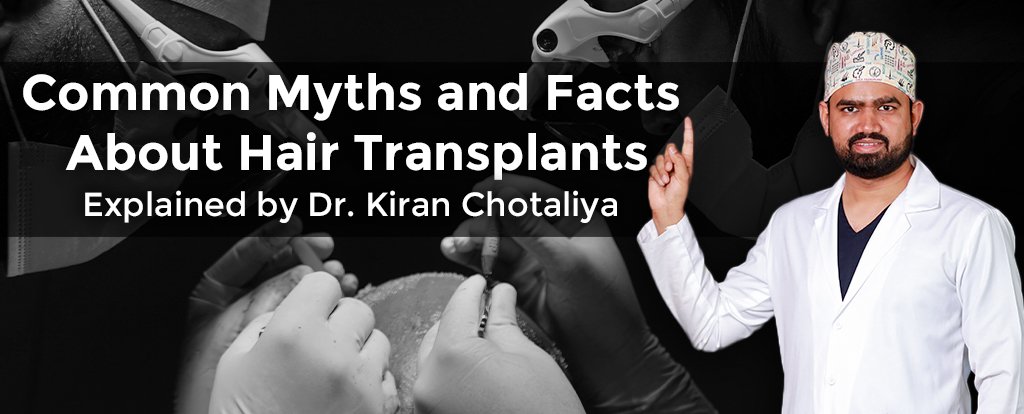Hair transplant procedures have gained immense popularity as a reliable solution for hair loss. However, several myths surround this transformative treatment, often deterring people from opting for it. Dr. Kiran Chotaliya, a renowned hair transplant expert, sheds light on these misconceptions and shares the facts to help individuals make informed decisions.
Understanding Hair Transplants: Dispelling Misconceptions
Myth 1 – Hair Transplants Are Painful
Fact: Modern hair transplant techniques, such as Follicular Unit Extraction (FUE) and Direct Hair Implantation (DHI), are minimally invasive and performed under local anesthesia. Patients typically experience little to no pain during the procedure, with only mild discomfort during recovery.
Myth 2 – Hair Transplants Look Unnatural
Fact: With advancements in technology and the expertise of skilled surgeons like Dr. Chotaliya, hair transplants today deliver remarkably natural results. Each graft is placed meticulously to mimic the natural growth pattern, ensuring seamless blending with existing hair.
Myth 3 – Hair Transplants Are Only for Men
Fact: Hair loss affects both men and women, and hair transplants are equally effective for both genders. Women experiencing thinning hair or bald spots can benefit from personalized transplant procedures.
Myth 4 – Transplanted Hair Doesn’t Last
Fact: Hair transplants involve relocating healthy hair follicles from donor areas, usually the back of the scalp, to thinning or balding areas. These follicles are resistant to hair loss and typically provide long-lasting results with proper care.
The Science Behind Hair Transplants
Myth 5 – Hair Transplants Are Suitable for Everyone
Fact: Not everyone is an ideal candidate for a hair transplant. Factors like the availability of donor hair, the extent of hair loss, and overall health determine eligibility. A consultation with a specialist like Dr. Kiran Chotaliya is crucial to assess individual suitability.
Myth 6 – Results Are Immediate
Fact: Patience is key. While the initial healing phase takes a few weeks, noticeable hair growth begins around three months after the procedure. Full results typically appear within 9–12 months.
Lifestyle and Maintenance Myths
Myth 7 – Transplanted Hair Requires Special Products
Fact: Once the transplanted hair follicles have settled, they behave like natural hair. There’s no need for special products or treatments beyond a regular hair care routine recommended by your doctor.
Myth 8 – Hair Transplants Stop Hair Loss Entirely
Fact: While a hair transplant addresses existing baldness, it doesn’t prevent further hair loss in untreated areas. To manage ongoing hair thinning, additional treatments like medications or PRP therapy may be recommended.
Myth 9 – Hair Transplants Are Risky
Fact: Hair transplant procedures are safe when performed by a qualified and experienced surgeon like Dr. Kiran Chotaliya. Potential risks like infection or scarring are minimal and can be effectively managed with proper post-operative care.
Cost-Related Misconceptions
Myth 10 – Hair Transplants Are Only for Celebrities
Fact: While hair transplants were once considered a luxury, they are now more accessible and affordable. Clinics like Dr. Chotaliya’s offer flexible plans to suit various budgets without compromising quality.
Myth 11 – Cheap Transplants Are Just as Good
Fact: The cost of a hair transplant often reflects the expertise of the surgeon, the quality of the equipment, and the level of care provided. Choosing an inexperienced surgeon to save money can lead to unsatisfactory results and additional corrective procedures.
FAQs on Hair Transplants
1. Is a hair transplant permanent?
Yes, transplanted hair follicles are permanent and resistant to hair loss, though untreated areas may still thin over time.
2. Can I dye or style my transplanted hair?
Absolutely! Once the transplanted hair has fully grown, it can be treated just like your natural hair.
3. Are there non-surgical alternatives to hair transplants?
Yes, treatments like PRP therapy, medications, and laser therapy can complement or delay the need for a transplant.
4. How long does the recovery take?
Most patients resume normal activities within a week, though full healing and hair growth take several months.
5. Will people know I’ve had a hair transplant?
Modern techniques like FUE ensure minimal scarring and natural results, making it difficult for others to detect a hair transplant.

